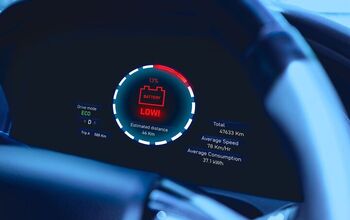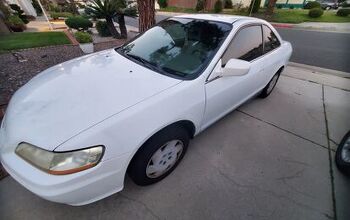General Motors Death Watch 165: The VEBA Fiasco
As GM's fortunes head for their inevitable denouement, it's time to pause and reflect on the deal that revolutionized the American automaker's labor relations. I speak here of the multi-billion dollar bribe paid to the United Auto Workers (UAW) to cut their sky-high wages and benefits down to size. In exchange for a new Voluntary Employees Beneficiary Association (VEBA) health care trust, the union accepted a two-tier wage system. At a stroke, Motown became competitive with the transplants, while the UAW protected its members' health care benefits for all time. In theory.
Until now, analyzing the agreement was impossible. After the strike-busting health care deal was announced in September, GM and the UAW asked for– and received– a legally binding blackout on final negotiations.
Last Thursday, the UAW sued GM in U.S. District Court. The “non-hostile” lawsuit is designed to secure court approval for changes to the union's health care coverage for 500k or so GM retirees and spouses, as well as thousands of current UAW workers. If the court approves, the new health care VEBA will commence in 2011.
Thanks to the suit, crucial details of the deal are finally coming to light. According to court records, GM has agreed to pay $33b to $36.5b into the trust. Although the figure is in line with expectations, it's an epic financial burden.
[For perspective, GM’s current market capitalization is $13.6b. As of December 31, 2007, GM claims that its total current liquidity– cash, marketable securities and readily available assets from the current VEBA– is $27.3 billion.]
At the moment, we don’t know the exact timing or formula for GM’s contribution to the VEBA– other than the fact that it includes varying levels of cash and notes convertible into stock. But we do know that GM has agreed to make up to 20 annual $165m “backstop payments” to the VEBA if its funding level “can’t provide current benefit levels for at least 25 years from the date of the required payment.”
In other words, GM is planning for failure. Of course, they’re not the only ones. According to UAW Vice President Cal Rapson, “Since the money for our benefits will be paid up front, our retirees will have important protections in case of changes in GM's financial condition."
Yes, well, who’s going to protect UAW members from their own union’s malfeasance? Under the terms of the agreement filed with the court, an 11-member committee will run the GM VEBA trust. The court will pick six members; the UAW International President appoints five, who "may be removed or replaced, and a successor designated, at any time by written notice from the UAW International president." All members must adhere to a code of ethics that bars them from holding a “substantial interest” in any company doing business with the trust. There's no word on committee members' compensation.
Supposedly, the fact that a majority of VEBA administrators will be court-appointed “outsiders” will protect union members' health care coverage. Under the trust agreement, participants and beneficiaries will be "reasonably informed as to how the trust's assets are used and cared for" on an annual basis. In practice, one need only look at GM’s Board of Bystanders to understand the pitfalls of relying on "independent" overseers.
And GM’s Board is a model of probity when compared to the UAW's long, sordid history of corruption. The National Legal and Policy Center’s website lists 84 cases of UAW/CAW corruption, involving millions of dollars. The links only go back to 1998, and who knows how many cases of corruption weren't uncovered?
In short, anyone who believes that the UAW will keep its mitts off of the $36.5b VEBA does so in the face of common sense and a firmly established record of criminal behavior.
But even if you discount the possibility that the VEBA may be ransacked by UAW bosses and their cronies, who’s to say that this union-intensive GM VEBA committee will be effective? Lest we forget, GM is paying the trust pennies on the dollar– significantly less than the company's total anticipated health care costs.
There’s only way for the VEBA to maintain the current of health care coverage: improve efficiency. That’s a fancy way of saying the VEBA administration will have to cut costs, either by eliminating waste and fraud or finding new ways to "economize" on members' health care. What are the odds? And what are the odds that health care costs won’t continue to skyrocket, outpacing any efforts to rein them in?
And despite the UAW’s claim that GM’s health care VEBA will be front-loaded to protect union members from a GM Chapter 11, the court records tell a different tale. “Whether benefits or participant contributions would have to be adjusted by the VEBA trustees thereafter will depend on many factors, including whether GM remains financially viable so it can make the required payments on time.”
There’s no question that the UAW – GM VEBA agreement was a game-changer. But it is NOT a game winner. GM's eventual labor cost reduction will not, by itself, lead to competitive products. Meanwhile, UAW members’ health care now depends on its leaders’ integrity AND GM’s business acumen– neither of which should instill confidence in the rank and file who spent their lives building security for themselves and their dependents.
More by Robert Farago
Latest Car Reviews
Read moreLatest Product Reviews
Read moreRecent Comments
- Kwik_Shift_Pro4X What's worse than a Malibu?
- MaintenanceCosts The current Malibu is poorly packaged; there's far more room inside a Camry or Accord, even though the exterior footprint is similar. It doesn't have any standout attributes to balance out the poor packaging. I won't miss it. But it is regrettable that none of our US-based carmakers will be selling an ordinary sedan in their home market.
- Jkross22 You can tell these companies are phoning these big sedans in. Tech isn't luxury. Hard to figure out isn't luxury.This looks terrible, there are a lot of screens, there's a lot to get used to and it's not that powerful. BMW gave up on this car along time ago. The nesting doll approach used to work when all of their cars were phenomenal. It doesn't work when there's nothing to aspire to with this brand, which is where they are today. Just had seen an A8 - prior generation before the current. What a sharp looking car. I didn't like how they drove, but they were beautifully designed. The current LS is a dog. The new A8 is ok, but the interior is a disaster, the Mercedes is peak gaudy and arguably Genesis gets closest to what these all should be, although it's no looker either.
- Ajla My only experience with this final version of the Malibu was a lady in her 70s literally crying to me about having one as a loaner while her Equinox got its engine replaced under warranty. The problem was that she could not comfortably get in and out of it.
- CoastieLenn Back around 2009-2010, a friend of mine had a manual xB and we installed a Blitz supercharger kit. Was a really fun little unit after that.


































Comments
Join the conversation
MPLS, When it comes to bosses, I vote with my feet. I have been my own boss, but figured out I was really working for the government. I plan to go back to work for someone else and let them play with Uncle Sugar and the 50 dwarves. I will make more money without having to spend so much on lawyers and accountants who don't know their jobs worth a flip. If you think your boss is a pain in the butt, try dealing with KPMG. They treat you like crap, and you get to pay them!
"To expand on your CTS example, it has won MT COTY, received a pick over the 2008 3-series and 2008 C-Class from Consumer Reports, IIHS top pick, CNET technology COTY along with numerous design, safety and performance accolades. The specs and options mirror a 5-series with a price that starts $10,000 less. Cadillac is also at the top of the 2007 J.D. Power Dependability Survey behind only Buick and Lexus, which are tied for first place. " ...and not gained them one half of a percent of market share over their competition.